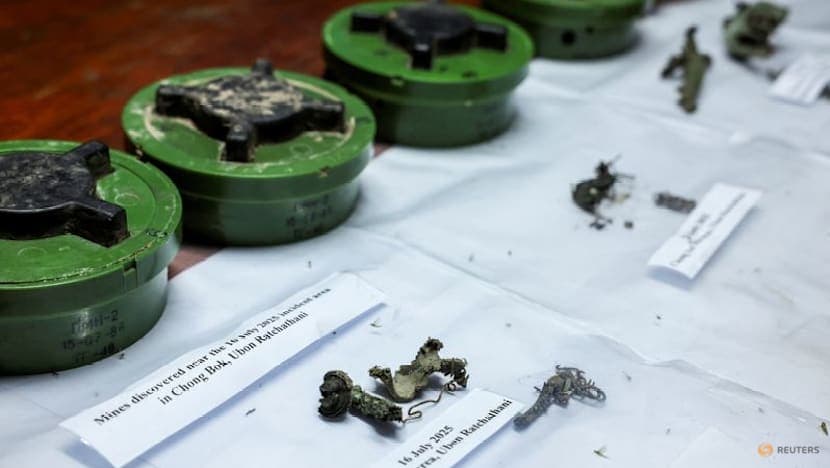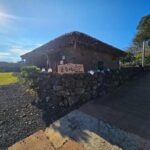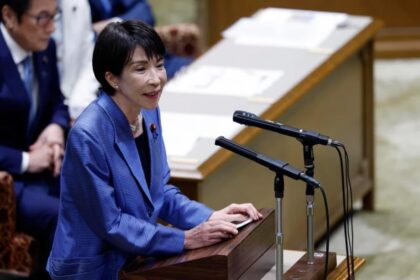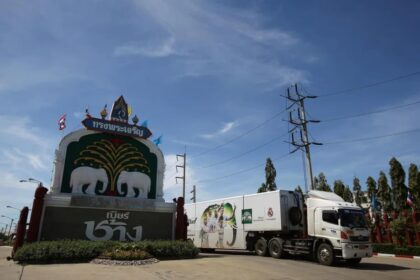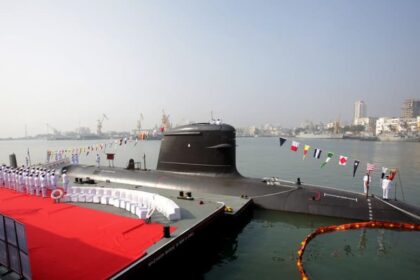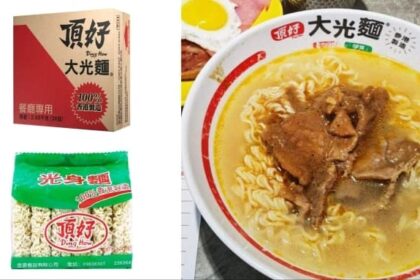Why the landmine blasts matter now
A routine border patrol turned into a regional crisis in mid July when a Thai unit near a contested stretch of the Thai Cambodia frontier triggered a buried device. The blast severed a soldier’s ankle and set off a chain of accusations that quickly spilled beyond the jungle. Within days, Thai and Cambodian forces traded artillery and air strikes before outside mediation pressed both sides into a ceasefire. At the heart of the dispute is a familiar and deadly object, the PMN-2 antipersonnel mine, a Soviet era design that both countries have pledged not to use. Thai officials say at least six soldiers have been maimed since July by mines they insist were newly planted. Cambodia rejects that narrative. Phnom Penh says the blasts came from legacy mines left by decades of conflict.
- Why the landmine blasts matter now
- How the July clashes unfolded
- What the mines reveal
- Competing claims and official statements
- Treaty obligations and what compliance requires
- Diplomacy, courts, and the fight over narrative
- Domestic politics add fuel to the fire
- Lives upended along the frontier
- What could ease the crisis now
- The Bottom Line
Thai units say they found ten PMN-2 devices between July 18 and July 20 near the site of the first injury, and they shared images and demining footage with diplomats and analysts. Independent specialists who examined the material say the mines appear fresh in the ground, lacking the cracking, staining, root growth, or insect nesting often seen on ordnance that has weathered for years. They stop short of saying who planted them. Cambodian demining authorities counter that soil conditions, shade, and seasonal flooding can preserve ordnance. The region is one of the most mined stretches of land in Asia, and both governments have spent years clearing hazards. The current quarrel matters beyond the border because both states are bound by the Ottawa Convention banning antipersonnel mines, at a time when some governments in Europe, under pressure from war, are debating the future of that ban.
How the July clashes unfolded
Thai officials say the first blast struck on July 16 on Thai soil near Ubon Ratchathani province opposite Cambodia’s Preah Vihear. Two more explosions followed along patrol routes in the same corridor in late July. On July 24, artillery fire and air operations flared across the forested ridge lines. The fighting lasted five days, killing at least 43 people and uprooting well over 300,000 residents on both sides. Border crossings closed, ambassadors were recalled, and a heated public campaign unfolded online and on television in both capitals. Mediators from Malaysia, working with the United States and regional partners, coaxed the militaries into a halt to major operations late in the month.
The ceasefire reduced heavy fire, yet the landmine incidents did not stop. Thai commanders reported additional injuries from hidden devices near the same paths. They invited foreign diplomats and selected media to observe demining teams lifting PMN-2 mines from shallow soil between July 18 and July 23. Cambodia rejected the claim that these devices were new. Officials in Phnom Penh argued that Thai patrols left agreed routes and walked into known hazardous ground on the Cambodian side. The issue of where the line runs is itself contested, a legacy of colonial era agreements and an International Court of Justice ruling in 1962 that awarded the Preah Vihear temple to Cambodia while leaving adjoining plots undefined.
Why the boundary remains unsettled
The demarcation still hinges on maps from the early 1900s when France governed Indochina. Thailand prefers to resolve disagreements through a joint commission, citing past grievances at the court. Cambodia wants outside adjudication, including the United Nations and a return to the court. That gap, combined with nationalist politics in both countries, turns routine patrols and even temple access into flashpoints.
What the mines reveal
The PMN-2 mine is a circular pressure device developed in the Soviet Union and widely exported. Its black or green bakelite or plastic case contains a molded explosive charge and a fuze that triggers when a soldier applies foot pressure. The plastic body frustrates metal detectors, and the trigger mechanism remains sensitive for years if stored well. Both Thailand and Cambodia are parties to the Ottawa Convention, which prohibits use, production, and stockpiling. Thailand says it does not deploy PMN-2 mines. Cambodia says it destroyed stockpiles years ago.
In the recent cases, analysts highlighted several signs consistent with recent placement. The casings showed minimal UV bleaching. Factory markings were legible. No roots or leaf litter had woven the devices into the soil. The mines appeared shallowly buried and were clustered along paths Thai units had used for routine patrols. Those clues point to recency, yet they do not identify the responsible hand. Mines can be moved, replanted, or disturbed by rain and wildlife. Boxes of unused mines from old caches sometimes surface in border economies and can end up in the ground years later.
Why mine forensics rarely name the planter
Determining age is not the same as determining authorship. Investigators need chain of custody for each device, geotagged photographs, blast crater analysis, and a secure site that has not been tampered with. They also need access to patrol logs and communications from both militaries. That is why Cambodian demining authorities have urged a neutral fact finding team, and why Thai officials are seeking a process under the Ottawa framework and at the United Nations. Without a jointly accepted inquiry, each side can claim the science supports its narrative.
Competing claims and official statements
Thai commanders have framed the blasts as a treaty breach and a threat to sovereignty. Major General Winthai Suvaree, a spokesperson for the army, said the pattern points to deliberate action by Cambodia. He added that Thailand has favored restraint in the face of repeated violations.
“Cambodia continues to covertly plant landmines,” he said, adding that the Thai army has not been the initiating party.
Winthai warned that if incidents continued, Thailand could invoke the right of self defense under international law to protect its personnel.
Phnom Penh rejects the allegation. The Cambodian Ministry of National Defence posted an emphatic denial and pointed to its record as a champion of demining.
“We have never used, produced, or deployed new landmines under any circumstances, and we strictly and fully honour our obligations under international law.”
Cambodia’s mine action authority has asked for an impartial investigation. Its leaders say that appearance alone cannot determine when a device was buried and that heavy rains and shaded soil can make old ordnance look new. Thai officials counter that the condition and placement of the mines, along with the type, leave little doubt.
Treaty obligations and what compliance requires
The Ottawa Convention, also known as the Mine Ban Treaty, bars the use, stockpiling, production, and transfer of antipersonnel mines. It commits states to clear contaminated areas, assist victims, and cooperate on transparency. Thailand and Cambodia have reported stockpile destruction and ongoing clearance. Re planting any mine would break the treaty and carry diplomatic costs. There is no automatic sanctions regime, yet states face censure at review meetings, and donors can condition funding for demining and military cooperation.
The treaty also provides ways to resolve disputes. A party can request clarification, seek a special meeting of states, or invite a fact finding mission. Those mechanisms aim to lower tensions by bringing evidence into a shared forum. The Thai government has begun raising the matter through diplomatic channels tied to the treaty and at the United Nations. Cambodia says there is no verified evidence of new use and that it continues to clear historic contamination.
Diplomacy, courts, and the fight over narrative
The military flare up triggered a rapid political spiral. Thailand closed several northeastern border crossings, pulled its ambassador, and expelled Cambodia’s envoy. Cambodia reciprocated, downgraded relations, and imposed an array of trade and cultural curbs. Both governments accused each other of crossing into disputed ground and of breaking a truce that had barely taken hold.
Mediators stepped in. Malaysia, as Association of Southeast Asian Nations chair, convened talks with backing from the United States and support from regional partners. The result was a ceasefire late in July, followed by a set of steps that included direct communication between local commanders, restraints on heavy weapons, and the deployment of ASEAN observers in contested areas. Cambodian officials have urged that the broader border dispute be settled at the International Court of Justice, while Thai leaders prefer bilateral mechanisms and resist the court’s jurisdiction because of past losses tied to the Preah Vihear case.
The information domain has been as active as the front line. Cambodian state linked and social media accounts amplified aggressive claims, including several false reports about downed jets and poison gas. Thai authorities responded with official statements and controlled media visits to mine sites, yet struggled to match the tempo online. The narrative battle matters inside both countries, where national pride and painful history shape public patience for compromise.
Domestic politics add fuel to the fire
In Bangkok, friction between the elected leadership and the army complicated crisis management. A leaked conversation involving the prime minister’s family further strained trust. The premier was suspended in early July while an ethics inquiry unfolded, weakening civilian authority at the peak of the border emergency.
In Phnom Penh, former leader Hun Sen retains enormous influence over the ruling party and the security services. His presence in the information space has underlined Cambodia’s hard line and helped rally domestic support. Statements from some Thai military figures about retaking disputed temples added to the hawkish mood, while Cambodian leaders cast Thailand as the aggressor. These currents shape decisions in the field as much as formal orders.
Lives upended along the frontier
The human cost runs far beyond the front lines. The July exchanges killed dozens and forced more than 300,000 people to evacuate homes near the forested escarpments that mark the border. Villagers who depend on foraging, farming, and cross border trade now avoid paths that once felt safe because they fear hidden explosives. Thai soldiers like Sergeant Tanee Paha, who lost limbs in recent blasts, personify a danger that lingers long after guns fall silent.
Economic pain followed quickly. Border closures choked what had been more than 10 billion dollars in annual trade. Cambodian immigration authorities recorded waves of migrant workers returning from Thailand, with hundreds of thousands coming back through Poipet in the weeks after the fighting. That flow cut remittances that reached 2.8 billion dollars last year, a significant share of Cambodia’s economy, and pushed up unemployment near the frontier. Thai businesses that rely on Cambodian labor faced higher costs and delays.
Shifts in supply chains have been visible in markets and factories. Cambodian retailers scrambled to replace Thai goods that had dominated store shelves, while Vietnamese suppliers filled gaps, often at lower prices for farmers selling across the border. Delays hit vehicle and electronics imports that once moved easily along the corridor. Tourism suffered as well, with visitor numbers to sites like the eleventh century Preah Vihear temple sliding during the crisis. Damage at the temple complex reduced income for small vendors who depend on steady flows of pilgrims and tourists.
What could ease the crisis now
A credible, independent investigation into the landmine incidents would lower the temperature and help both sides move forward. A team agreed by both governments, drawing on technical bodies that specialize in mine action, could gather devices, map blast sites, study soil and weather conditions, and review patrol logs. Findings could be presented under the Ottawa Convention’s procedures so that evidence, not rhetoric, anchors the debate.
Practical steps on the ground can reduce risk quickly. Both militaries can publish updated safe route maps, increase joint patrols in clearly agreed corridors, and set up a hotline between local commanders. Expanded mine clearance near villages and along patrol paths would save lives regardless of blame. ASEAN observers already in place can widen coverage, while a pause on live fire exercises near contested areas would signal restraint.
Diplomats can help reopen trade and travel in stages tied to verifiable steps. Reinstating ambassadors and easing bans on goods and cultural content would cut the economic pain that now feeds hardline voices. Clear public guidance on misinformation, issued jointly where possible, would slow the online race to the bottom. None of these moves resolve the century old border puzzle, yet they can turn down the heat so that technical teams and negotiators can work.
The Bottom Line
- Thai patrols triggered landmine blasts in July, injuring multiple soldiers and igniting a border crisis.
- Independent specialists say the PMN-2 mines look freshly laid, but there is no verified attribution.
- Cambodia denies planting new mines and calls for an impartial investigation.
- Five days of fighting in late July killed at least 43 people and displaced more than 300,000.
- A ceasefire brokered with Malaysian leadership and United States support introduced ASEAN observers to contested areas.
- Thailand is pursuing the issue through the Ottawa Convention and the United Nations, citing treaty violations.
- The border dispute remains unresolved, with Cambodia favoring the International Court of Justice and Thailand preferring bilateral talks.
- Trade closures, migrant returns, and disrupted tourism have hurt communities on both sides.
- Joint technical steps, including independent fact finding and expanded demining, could reduce risk and rebuild trust.
- Careful crisis management is needed so that a mine incident does not pull the region back into open conflict.


